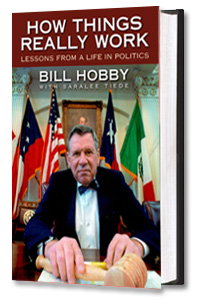Texas has a new telescope, a 10-meter giant light bucket that this month started peering into the dark skies of west Texas.
The Hobby-Eberly Telescope, officially dedicated and open for business at the University of Texas at Austin’s McDonald Observatory in Fort Davis, is a scientific landmark, a milestone in engineering. This telescope should help unlock the mysteries of black holes and dark matter, providing more clues to the origin of our universe.
It has already been a finalist for Discover Magazine’s Aviation and Aerospace Award because it does for $13.5 million much of what the Keck Telescope in Hawaii does for $100 million. In fact, the new telescope is a classic example of what American scientists can accomplish when asked to do more for less.
The HET saves money three ways. Its giant mirror was built for about one-seventh the cost of the other 10-meter telescope because it is constructed of many one-meter mirrors rigged to catch approximately as much light as one. It tracks only one way across the sky, which is less flexible than other instruments that revolve in two directions, but perfectly adequate for following stars and other objects in their nightly trajectory.
And since its data goes into computers rather than the eyes of astronomers, scientists can observe from their home bases in Germany, California or Pennsylvania and save travel expenses.
It is also an excellent example of cost-effective collaboration. The telescope is located at the University of Texas at Austin’s observatory, but four universities shared construction costs and will share viewing time.
It is a magnificent achievement, but as McDonald Observatory Director Frank Bash says, “The observatory does not produce research. People do.”
And it was people who produced the Hobby-Eberly Telescope, starting with the visionary, Harlan Smith. Before his death in 1991, Harlan directed McDonald Observatory. Harlan wanted to land men on Mars by 2003 in ships powered with ice found on the moon. He saw a 10-meter telescope for McDonald Observatory at a time when most Texans were totally preoccupied in figuring out where the oil boom had gone.
Harlan’s great gift was not that he saw visions but that he could make others see the visions. He taught many of us astronomy on bright clear nights on Mount Locke, without the aid of any telescope.
But Harlan’s vision would still be a dream without Larry Ramsey and his partner Daniel Weedman, Penn State astronomers who figured out how to build a really big telescope for a bargain basement price. At the time when Harlan wanted to build his 10-meter telescope, the idea of building a $60 to $100 million telescope in Texas was preposterous.
But Larry Ramsey and Daniel Weedman had an idea that could get you 70 percent of the sky for 15 percent of the cost. Don’t build one 10-meter mirror. Build lots of one-meter mirrors and mount them on a lattice in a way that will catch most of the light at a fraction of the cost. Building their mirrors at Beaver Stadium in State College, Pennsylvania, they demonstrated American ingenuity at its finest.
But Harlan’s vision and Larry Ramsey’s idea would still be nice drawings without Frank Bash, the endlessly patient, tireless, doggedly persistent fundraiser and dealmaker who now directs McDonald Observatory, made the spectroscopic survey telescope a reality. Frank forged partnerships with Penn State University, Stanford University, Ludwig Maximillian University in Munich and Georg-August University in Goettingen.
But even with Harlan’s dream, Larry’s brilliant idea and Frank’s partnerships, we wouldn’t have a telescope with Tom Sebring. It took a world class project director to translate drawings and ideas into steel, glass and concrete on time and on budget. And remember that this was a case of first impression, a one of a kind, finely tuned instrument with a near-zero tolerance for mistakes.
This telescope is a magnificent achievement. Thanks to the people who did it.

